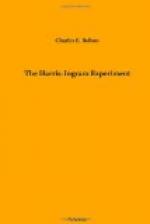Two thousand acres of land near the mills will be properly allotted and improved by the company for homes for the employees, and practical architects have been secured. It is further the wish of the steel company that each employee shall own a good home. The size of each lot is 50 ft. x 200 ft. and the price per lot is $50 which is in proportion to the original cost and improvement of the allotment, so that the employees in advance will thus secure all the profits that result from any increased value of the lots. This is only just.
A Stock and Building Bureau will be established, and money, at 4%, will be furnished the employees to build comfortable homes. This bureau created and officered by the employees will attend to the purchase and sale of stock, lots, the construction of homes, and the payment for the same. When for any reason, an employee desires to sever his connection with the steel company, his stock in the company and his home, if sold, must first be offered at a fair price to the Stock and Building Bureau.
By this scheme capital and labor will have equal interests in the Harris-Ingram Steel Co., also an equal voice in the management of the steel company’s welfare. Should capital and labor disagree, then the matter in dispute, with all the facts, and before any strike on the part of labor shall occur, shall at once be submitted to arbitration, and the decision of the arbitrators shall be final.
Signed by
George Ingram,
President of The Harris-Ingram Steel
Co.
In eight months George Ingram had spent of the five millions at his disposal three million dollars on the steel plant. A working capital of $500,000 was deposited in four banks, and the balance of one and a half millions was invested in call loans, and so held ready to loan in small amounts at 4%, to aid employees in securing their quota of stock, a lot and house.
In twelve months, the $2,500,000 stock of the company, allotted to labor, had been subscribed for by the employees, over a thousand pretty cottages, costing from $1,000 to $2,500 each, were built or in process of construction, and nearly three thousand lots had been bought by the workmen.
A Co-operative Supply Bureau was organized and managed in the interests of the workmen, to furnish food, clothing, and all the necessary comforts of life at about cost prices. The profits of the bureau, if any, were to be divided annually among purchasers, in proportion to purchases made.
Women in Harris-Ingram voted on several matters the same as the men. Saloons, all forms of gambling, and corruption in politics were tabooed. Sewerage was scientifically treated by the use of chemicals and machinery. Storm water only was sent to the lake. The valuable portions of the sewerage were utilized on adjacent vegetable farms. At Harris-Ingram electrical energy supplied water free for streets, lawns, and gardens, and filtered water was delivered free for family purposes. All the public buildings and homes were heated and lighted by electricity.




